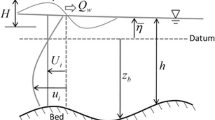Abstract
A numerical model of the resuspension, deposition, and transport of fine-grained, cohesive sediments has been developed and applied. An essential part of this model is an accurate and physically realistic description of the sediment bed and the resuspension of the bottom sediments due to physical processes. The description is based on data from recent experimental and field work on fine-grained sediments. Pertinent results from this work have been incorporated into the present model, and as part of the calculation, changes in the resuspension properties of the sediment bed with time due to resuspension, deposition, and compaction can be approximately determined. Vertically integrated differential equations were used to approximate the hydrodynamic and sediment transport equations. A volume integral method was used to derive finite difference equations which are second-order accurate, explicit, and locally conservative. A unique feature of the numerical model is that it can successfully treat conditions at open boundaries where both incoming and outgoing waves or disturbances may be present.
The model has been applied to the resuspension, deposition, and transport of fine-grained sediments in (1) the Raisin River, a small polluted stream flowing into Lake Erie; (2) a river flowing into a lake or ocean with a cross-flow; and (3) a time-dependent flow in a simple estuary as affected by tidal currents. The formation of erosional and depositional areas under various conditions is demonstrated.
Similar content being viewed by others
References Cited
Chan, R. 1977, Finite difference simulation of the planar motion of a ship, Second International Symposium on Computational Ship Hydrodynamics, p. 39–52.
Engquist, B., and A. Majda, 1977. Abosorbing boundary conditions for the numerical simulation of waves, Mathematics of Computation, v. 31, p. 629–651.
Hunt, J. R., 1982, Self-similar particle size distributions during coagulation: theory and experimental verification: Journal of Fluid Mechanics, v. 122, p. 169–185.
Ives, K. J., 1978. Rate theories,in K. J. Ives, ed., The Scientific Basic of Flocculation: Alphen aan den Rijn, The Netherlands, Sijthoff and Noordhoff International Publishers, p. 37–61.
Kreiss, H. O., 1966,in D. Greenspan, ed., Proceedings of a Symposium at the University of Wisconsin: New York, Wiley.
Lee, D. Y., S. W. Kang, and W. Lick, 1981, The entertainment and deposition of fine-grained sediments: J. Great Lakes Research, v. 7, p. 224–233.
Lick, W., 1982, Entrainment, deposition and transport of fine-grained sediments in lakes: Hydrobiologia, v. 91, p. 31–40.
Lick, W., and S. W. Kang, 1987, Entrainment of sediments and dredged materials in shallow lake waters: J. Great Lakes Research, in press.
Lick, W., K. Ziegler, and J. Lick, 1986, Interior and boundary difference equations for hyperbolic differential equations: Numerical Methods for Partial Differential Equations, v. 2, p. 157–172.
Lick, W., K. Ziegler, and J. Lick 1987, Open boundary conditions for hyperbolic equations: Numerical Methods for Partial Differential Equations, in press.
MacIntyre S., W. Lick, and C. H. Tsai, 1986, Entrainment of cohesive riverine sediments, UCSB Report.
Orlanski, I., 1976, A simple boundary condition for unbounded hyperbolic flows: J. Computational Physics, v. 21, p. 251–269.
Pearson, R. A., 1974, Consistent boundary conditions for numerical models that admit dispersive waves: J. Atmospheric Sciences, v. 31, p. 1481–1489.
Tsai, C.-H., and W. Lick, 1986, A portable device for measuring sediment resuspension: J. Great Lakes Research, v. 12, no. 4, p. 314–321.
Tsai, C.-H., S. Iacobellis, and W. Lick, 1987, The flocculation of fine-grained lake sediments due to a uniform shear strees: J. Great Lakes Research, in press.
Ziegler, C. K., and W. Lick, 1986, A numerical model of the resuspension, deposition, and transport of fine-grained sediments in shallow waters: UCSB Report ME-86-3.
Author information
Authors and Affiliations
Rights and permissions
About this article
Cite this article
Ziegler, C.K., Lick, W. The transport of fine-grained sediments in shallow waters. Environ. Geol. Water Sci 11, 123–132 (1988). https://doi.org/10.1007/BF02587771
Issue Date:
DOI: https://doi.org/10.1007/BF02587771




